CAA News Today
Meet the 2022 Wyeth Award Winners
posted by CAA — November 30, 2022
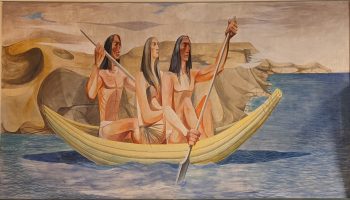
Anton Refregier, History of San Francisco, 1941-1948, mural, panel 2: “Indians by the Golden Gate,” Rincon Center, San Francisco, California, public domain
Since 2005, the Wyeth Foundation for American Art has supported the publication of books on American art through the Wyeth Foundation for American Art Publication Grant, administered by CAA. The 2022 grantees are:
- Siobhan Angus, Camera Geologica: Temporality, Materiality, and Mining in Climate Breakdown, Duke University Press
- Julia Bailey, Painting and Paranoia: The Specter of Communist Art in Cold War USA, University of Illinois Press
- Janet Berlo, Not Native American Art? Fakes, Replicas, and Invented Traditions, University of Washington Press
- Stephanie Buhmann, Frederick Kiesler: Galaxies, The Green Box, Berlin
- Colby Chamberlain, Fluxus Administration: George Maciunas and the Art of Paperwork, University of Chicago Press
- Jessica L. Horton, Earth Diplomacy: Indigenous American Art and Reciprocity, 1953–1973, Duke University Press
- Darren Newbury, American Perspectives in Africa: Photographic Diplomacy and the Cold War Imagination, Penn State University Press
- Louise Siddons, Good Pictures Are a Strong Weapon: Laura Gilpin and Navajo Sovereignty, University of Minnesota Press
The list of all recipients of the Wyeth Foundation for American Art Publication Grant from 2005 to the present can be found here.
Meet the 2023 CAA-Getty International Program Participants
posted by CAA — November 29, 2022
CAA is pleased to announce this year’s participants in the CAA-Getty International Program. Now in its twelfth year, this international program, supported by the Getty Foundation, welcomes twelve new participants and four alumni to attend the 2023 Annual Conference in New York City. The goal of the CAA-Getty International Program is to increase international participation in CAA’s activities and the field of visual arts in academia, thereby expanding international networks and the exchange of ideas both during and after the conference. We look forward to welcoming this year’s participants!
At a pre-conference colloquium, the new participants will discuss key issues in the international study of art history together with CAA-Getty alumni and US hosts. The program will delve into topics such as postcolonial and Eurocentric legacies, decolonization of museums, scholarship and pedagogy, interdisciplinary and transnational methodologies, and the intersection of politics and art history. Learn more about the first ten years of the program in our online publication.
Program participants—art historians, curators, and artists—hail from multiple countries, expanding CAA’s international membership and contributing to an increasingly diverse community of scholars and ideas. Selected by a jury of CAA members from a highly competitive group of applicants, each participant will receive funding for travel, hotel accommodation, conference registration, CAA membership, and a per diem.
Alumni invited back to the 2023 conference will present at the Global Change, Crisis, and the State of the Visual Arts session while also connecting our new participants with our burgeoning group of nearly 150 CAA-Getty International Program alumni.
2023 PARTICIPANTS IN THE CAA-GETTY INTERNATIONAL PROGRAM

Marina Grzinic is a principal research associate at the Research Centre of the Slovenian Academy of Sciences and Arts (ZRC SAZU) in Ljubljana, Slovenia, where she is affiliated with the Institute of Philosophy. She holds a PhD in philosophy and is an artist with a forty-year career. She has been a professor at the Academy of Fine Arts Vienna, Austria, since 2003, in charge of the Studio of Conceptual Art (Post-Conceptual Art Practices) at the Institute of Fine Arts. Grzinic is the principal investigator of the Austrian Science Fund and Programm zur Entwicklung und Erschließung der Künste (FWF-PEEK) project “Conviviality as Potentiality” (2021–25). She was also the principal investigator of the FWF-PEEK project “Genealogy of Amnesia (Opposing Colonialism, Antisemitism and Turbo-Nationalism)” (2018–21). Her areas of expertise include contemporary philosophy, contemporary art, the study of coloniality and decoloniality, transfeminism, the analysis of racism, antisemitism, nationalism, and the study of memory and history in the context of resistance.

Amrita Gupta is an art historian, writer, educator, and editor who works across art education and cultural management. In 2002, she joined the Mohile Parikh Center (MPC), Mumbai, and became its program director in 2005, facilitating critical thinking by curating a wide range of innovative art education programs. She runs the website V-IDEO: Ideas worth Sharing, an archive of short videos on Indian artists for which MPC is the knowledge partner. She received an MFA in art history from Viswabharati University, Santiniketan 2002.
Her writings on modern and contemporary art have been published in anthologies, journals, and websites in India and internationally, and she has authored and edited art books for children. She was a visiting lecturer in art history at the Sir J. J. School of Art, Mumbai; a fellow at ARThink South Asia (ATSA); a research grantee from the India Foundation for the Arts, and curatorial advisor for Art1st Foundation, Mumbai. Her current art historical research is on Northeast India, framing the region as a “critical art geography” where one can attend to meanings that engage with global modernism and heterodox contemporaneity drawn through one’s own historical position. An essay from this research has been published in the book 20th Century Indian Art (Thames & Hudson, 2022). She is cofounder and executive editor of the independent e-journal, Partition Studies Quarterly which focuses on partition stories of Northeast India within the larger discourse of the partition in the subcontinent.
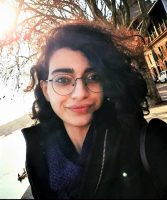
Delaram Hosseinioun was born and reared in Tehran, Iran, and seeks to reflect the voice of Persian women in creative and comparative narratives in spite of borders and restrictions. Delaram received an MA in literary criticism from the University of Exeter and another in cultural studies from KU Leuven University. Through her PhD project at Utrecht University, titled “Unveiling the Other: The Metamorphosis of Feminist Persian Art from the Mid-Twentieth Century to the Present Day,” Delaram draws from gender theories in French psychoanalysis, such as in the works of Hélène Cixous and Judith Butler, and continental philosophy, namely in the work of Mikhail Bakhtin and Jacques Derrida. Working with artists and scholars around the world, Delaram deciphers artworks as pictorial dialogues and as artists’ attempts to surpass sociocultural restrictions. The revelation and universality of the feminine voice frame her core vision. Delaram’s other passion is art journalism and interviewing artists beyond borders.

Brigitta Isabella is a researcher of art history, critical theories, and cultural studies. Her research trajectory revolves around the (im)mobility of artists and the (im)mobilization of art within the geopolitical and geoaesthetic terrains of transnational solidarity. By looking into the transnational traffic of artists, objects, and ideas, she reexamines the reciprocity between nationalism and internationalism and how artistic traces of Third World solidarity can play a discursive part in decentralizing global art history. She studied philosophy at Gadjah Mada University, Yogyakarta, Indonesia, and gained her MA in critical methodologies at King’s College, London. She is also a part of a research-action group called Kunci Study Forum & Collective and serves as the coeditor of Southeast of Now: Directions in Contemporary and Modern Art in Asia, a peer-reviewed journal published by NUS Press. She is a lecturer at the Faculty of Visual Arts in Indonesian Institute of the Arts, Yogyakarta.
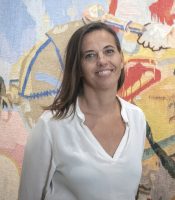
Żanna Komar, PhD, was born in Ukraine, lives in Poland, and is an art historian, theoretician of architecture, and exhibitions curator. She is a member of the academic staff at the Institute of European Heritage, part of the International Cultural Centre, Kraków, where she works as a content specialist. She specializes in urban studies, social and art history, and the theory and protection of cultural heritage. She is the author of numerous publications on the history of architecture and art, including the book Trzecie miasto Galicji. Stanisławów i jego architektura w okresie autonomii galicyjskiej (The third city of Galicia. Stanisławów and its architecture in the period of Galician autonomy, 2008). She writes about Art Nouveau, historicism, modernism, and contemporary art, and about totalitarian and modern architecture in present‑day Poland and Ukraine.
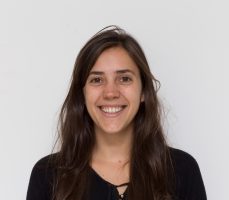
Larisa Mantovani holds a PhD in history from the Escuela Interdisciplinaria de Altos Estudios Sociales, Universidad Nacional de San Martín, Buenos Aires. She has a BA in art history and a teacher training degree in art history from Universidad de Buenos Aires. She is a postdoctoral fellow at the Research Center in Art and Heritage of the National Scientific and Technical Research Council (CIAP/UNSAM-CONICET). She works as an assistant professor of history of decorative arts I and II at the Universidad del Salvador. Both her dissertation and current postdoctoral research focus on applied arts and the links between art, education, and industry in Argentina in the first half of the twentieth century.

Thabang Monoa’s research interests involve art history, art criticism, visual culture, curatorial practice, and cultural studies. He completed his undergraduate studies at the Tshwane University of Technology and then went on to do a master’s degree in visual art at the Faculty of Art, Design and Architecture, University of Johannesburg. He later worked as an art historian in the faculty’s department of visual art. His doctoral study, which he undertook with the SARChI Chair in South African Art and Visual Culture, focused on the notion of Blackness in Afrofuturist aesthetics. Monoa is a member of the College Art Association (CAA) in the USA; a former council member of the South African Visual Art Historians (SAVAH); and is coconvenor of the Gerard Sekoto Winter/Summer School, which is administered through the Johannesburg Art Gallery. In his current capacity as a lecturer in Art History at the University of Cape Town’s Michealis School of Fine Art, Monoa continues to generate scholarly output concerning racial aesthetics, notions of futurity, and Black radical thought.

Haoxue Nie is an assistant professor at the School of Art and Humanities, Guangzhou Academy of Fine Arts. She holds a PhD in Western modern art history and theory from the China Academy of Art (2018). Her dissertation was published as a monograph in 2019 titled Beyond Boundaries: George Ault and Early Modern American Art. She was a recipient of the Getty Foundation grant for the 35th CIHA Congress (2019) and the international Travel Grant by Terra Foundation for American Art (2016).
Her research covers the first half of twentieth-century American art history, especially from the 1920s to the 1950s. Recently, she has been focusing on the visual ideology of cityscapes within this period and how they remained minor artworks in the mainstream of art history, as well as the concept of time, space, and subjectivity as formal, ideological, and psychological manifestations. The intertextuality among easel painting, modern photography, and films with urban themes in American modernism is also a part of her scholarly explorations.

Zuzanna Sarnecka is an assistant professor of art history at the University of Warsaw (Poland). She earned her PhD in history of art at the University of Cambridge (2017). She is the author of The Allure of Glazed Terracotta in Renaissance Italy (Brepols, 2021) and coeditor of The Agency of Things in Medieval and Early Modern Art. Materials, Power and Manipulation (Routledge, 2017) and The Materiality of Terracotta Sculpture in Early Modern Europe (Routledge, 2023). Her current research focuses on the adaptation of technique of tin-glazed earthenware from the Italian peninsula across Central Europe. In her work, she aims to construct more inclusive narratives through close investigation of microhistories that have long remained ignored, not because of the lack of sources, but because of the cult of masterpieces. She promotes multisensory perspective in studies of the arts of the past, as more immediately significant for the twenty-first-century beholder, than stylistic attributions and dating.

Jakub Stejskal is a MASH junior research group leader at the Department of Art History, Masaryk University, Brno, where he heads the research group Remote Access: Understanding Art from the Distant Past. He has held fellowship positions at eikones (University of Basel) and Freie Universität Berlin. He holds a PhD in aesthetics from Charles University, Prague. His research interests lie at the intersection of archaeology, art history, anthropology, and philosophical aesthetics. He is the author of Objects of Authority: A Postformalist Aesthetics (Routledge, 2022) and his work has appeared in Critical Inquiry, World Art, Journal of Aesthetics and Art Criticism, and RES: Anthropology and Aesthetics.

Cheryl Chelliah Thiruchelvam holds a PhD in art history and is currently attached to the Advertising Department, Faculty of Arts and Social Science at Universiti Tunku Abdul Rahman (UTAR), Malaysia. Her research interests are Hindu-Buddhist visual arts of the Southeast Asian region and to a lesser extent feminist studies. Her latest publication is a book chapter on the prevalence of the Ramayana epic in Malaysian visual arts for the book The Multivalence of an Epic: Retelling the Ramayana in South India and Southeast Asia (Manipal Universal Press, 2021). She also has a forthcoming coauthored essay entitled, “Tracing Indian Cultural Connections in Malaysia and Brunei: From Early Candis to Modern Art,” for the book Connected Histories of India and Southeast Asia: Icons, Narratives, Monuments that will be published by SAGE Publications India. Besides that, she is also interested in writing criticism, reviews, and commentary within the Malaysian art scene.
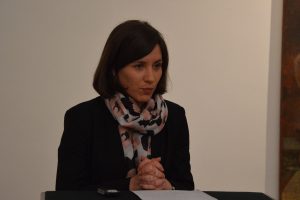
Tanja Trška is assistant professor at the Department of Art History, Faculty of Humanities and Social Sciences, University of Zagreb, Croatia, where she teaches courses on early modern art in Europe and present-day Croatia. She received her PhD in art history from the Scuola Normale Superiore in Pisa, Italy (joint supervision with the Faculty of Humanities and Social Sciences, University of Zagreb) in 2014. Her research interests center on early modern art and architecture, the exchange of cultural and artistic experiences between Italy and the eastern Adriatic coast, art patronage, and history of collections. She has collaborated on Croatian Science Foundation’s research project “Visualizing Nationhood: The Schiavoni/Illyrian Confraternities and Colleges in Italy and the Artistic Exchange with South East Europe (15th–18th centuries)” (2015–18) and is currently a team member of the research project “Provenance Research on Artwork in Zagreb Collections” (2020–24).
PARTICIPATING ALUMNI
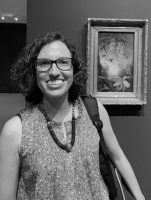
Patricia D. Meneses is an assistant professor of art history at the University of Campinas (Brazil). She earned her PhD in history of the visual arts at the University of Pisa (2009). She is the author of Baccio Pontelli a Roma. L’attività dell’architetto per Giuliano Della Rovere (Felici Editore, 2010) and editor of several books, such as Arte Não-Europeia: Conexões historiográficas a partir do Brasil (Estação Liberdade, 2020) and A imagen como experimento. Debates contemporâneos sobre o olhar (Milfontes, 2021). In 2019, she was Hans Jonas visiting professor at the University of Siegen, where she taught a course on “exotic” materials in art history. She is currently part of a Connecting Art Histories project sponsored by the Getty Foundation (“Teaching and Researching Non-European Art at Brazilian Universities”). Her research focuses on the connections between art, science, and ecology in the nineteenth century.

Natalia Moussienko is a leading research fellow at the Modern Art Research Institute of the National Academy of Arts of Ukraine (Kyiv). She is the author of numerous books and articles on art history, cultural diplomacy, cinema, and urbanism, including Art of Maidan (2016), Kyiv Art Space (2013), and Arts and Politics (2002). In 2016 the National Academy of Arts of Ukraine awarded Dr. Moussienko a gold medal for her achievements in cultural diplomacy. She was also awarded a Fulbright scholarship to conduct research at the Kennan Institute, Wilson Center, in Washington, DC (2011–12), and a Thesaurus Polonia Fellowship to study at the International Cultural Center in Krakow (2017 and 2022). Dr. Moussienko is an initiator and curator of Art of Maidan, a continuing project begun in 2014 to document the explosion of artistic creativity during the Revolution of Dignity in 2013–14 and a Russo-Ukrainian war premonition in it. Central to the project is a book and exhibition that has already been presented in nineteen locations in Ukraine, the United States, and Europe.

Shenouda Rizkalla Fahim Youssef is a trained archaeologist with extensive experience in archaeological fieldwork, database and collections management, and community outreach. His current research focus is on the museum practices in the Egyptian provinces, using the Akhenaton Museum in Minya, Egypt, as a case study. The museum, opening in 2023, will focus on the site of Tell el-Amarna, where the famous bust of Nefertiti, currently exhibited in the Egyptian Museum in Berlin, was found. The aims of the presentation are to analyze the archival resources for the history of the museum, develop community outreach programs by engaging the local population with the collection, and using this to develop avenues for future outreach activities. The results will be related to wider discussions of repatriation and postcolonial heritage management in Egypt.
Rizkalla received a PhD in Egyptology from Helwan University, Egypt. His research has been diverse, working on recording and translating Ptolemaic Period hieroglyphics, creating and executing site management strategies, and addressing the looting of archaeological sites. He has been a member of many excavations and site management missions in Egypt since 2012, has given numerous presentations and invited talks, and has written a number of academic reports and publications.

J. Kelechi Ugwuanyi is a senior lecturer in the department of archaeology and tourism, University of Nigeria, Nsukka. He is currently a postdoctoral research fellow at the Global Heritage Lab, Transdisciplinary Research Area: Present Pasts, University of Bonn, Germany. Kelechi has a PhD in heritage studies from the University of York, UK, and MA and BA in archaeology and tourism as well as a diploma in tourism and museum studies from the University of Nigeria. He is a coeditor of the Journal of African Cultural Heritage Studies and sits on the editorial board of the Studies in Contemporary and Historical Archaeology in Theory book series published by the Archaeopress. Kelechi’s research interests are critical heritage studies, museum, Indigenous knowledge systems, tourism, and contemporary archaeology. His current research revisits the originating communities of ethnographic archives collected from Africa during colonialism to reengage members of the descendant communities to understand their changing significance in the present.
Meet the Fall 2022 Millard Meiss Publication Fund Grant Recipients
posted by CAA — November 28, 2022

George Stubbs, A Lion Attacking a Horse, Oil on canvas, 1762, Yale Center for British Art, Paul Mellon Collection
MEET THE GRANTEES
Twice a year, CAA awards grants through the Millard Meiss Publication Fund to support book-length scholarly manuscripts in the history of art, visual studies, and related subjects that have been accepted by a publisher on their merits, but cannot be published in the most desirable form without a subsidy.
Thanks to the generous bequest of the late Prof. Millard Meiss, CAA began awarding these publishing grants in 1975.
FALL 2022 GRANTEES
Paloma Checa-Gismero, The Early Biennial Boom and the Making of Global Contemporary Art, Duke University Press
Denva Gallant, Illustrating the Vitae patrum: The Rise of the Eremitic Ideal in Fourteenth Century Italy, Penn State University Press
Katie Hornstein, Myth and Menagerie: Seeing Lions in Nineteenth-Century France, Yale University Press
Sujatha Meegama, Temples to the Buddha and the Gods: The Transnational Drāviḍa Tradition of Architecture in Sri Lanka, University of Hawaii Press
Morgan Ng, The Stratified City: Military Architecture and Urban Experience in Renaissance Italy, Yale University Press
Naomi Pitamber, Byzantium and Landscapes of Loss: The Recreation of Constantinople in the Laskarid and Palaiologan Eras, Cambridge University Press
Finalists for the 2023 Morey and Barr Awards
posted by CAA — November 28, 2022
CAA is pleased to announce the 2023 finalists for the Charles Rufus Morey Book Award and the two Alfred H. Barr Jr. Awards. The winners of the three prizes, along with the recipients of other Awards for Distinction, will be announced in January 2023 and presented during Convocation in conjunction with CAA’s 111th Annual Conference, February 15–18, 2023.
Charles Rufus Morey Book Award Shortlist, 2023
Cécile Fromont, Images on a Mission in Early Modern Kongo and Angola, Pennsylvania State University Press, 2022
Sylvia Houghteling, The Art of Cloth in Mughal India, Princeton University Press, 2022
Sonya S. Lee, Temples in the Cliffside: Buddhist Art in Sichuan, University of Washington Press, 2022
Natalia Majluf, Inventing Indigenism: Francisco Laso’s Image of Modern Peru, University of Texas Press, 2021
Thy Phu, Warring Visions, Duke University Press, 2022
Alfred H. Barr Jr. Award Shortlist, 2023
Darsie Alexander and Sam Sackeroff, eds., Afterlives: Recovering the Lost Stories of Looted Art, Yale University Press and the Jewish Museum, New York
Kristin Juarez, Rebecca Peabody, and Glenn Phillips, eds., Blondell Cummings: Dance as Moving Pictures, X Artists’ Books and Art + Practice
Victoria I. Lyall and Terezita Romo, eds., Traitor, Survivor, Icon: The Legacy of La Malinche, Yale University Press and Denver Art Museum
Julia Burtenshaw, Héctor García Botero, Diana Magaloni, and María Alicia Uribe Villegas, The Portable Universe / El universo en tus manos: Thought and Splendor of Indigenous Colombia, DelMonico Books and the Los Angeles County Museum of Art
Jessica Niebel, Hayao Miyazaki, DelMonico Books and the Academy Museum of Motion Pictures
Alfred H. Barr Jr. Award for Smaller Museums, Libraries, Collections, and Exhibitions Shortlist, 2023
Katherine D. Alcauskas, ed., Michael Rakowitz: Nimrud, DelMonico Books and Wellin Museum of Art, Hamilton College
Janet Dees, ed., A Site of Struggle: American Art against Anti-Black Violence, Princeton University Press and The Block Museum of Art, Northwestern University
Adriano Pedrosa and Tomás Toledo, eds., Afro-Atlantic Histories, DelMonico Books and the Museu de Arte de São Paulo Assis Chateaubriand
Janice Glowski, ed., The Pandemic Portraits by Nicholas Hill, The Frank Museum of Art, Otterbein University
CWA Picks: Fall 2022
posted by CAA — November 17, 2022
This fall, there are wonderful exhibitions devoted to the work of women artists. We have linked a few of them here through the theme of care and care’s connection to the urgent crisis in which legal protections for women’s bodily autonomy have been taken away right before our eyes. The artwork featured in the exhibitions below does not explicitly take up abortion bans and restrictions. Still, they provoke viewers to see women with complexity, and not as natural resources of care. With their inventive imagery, forms, materials, and ideas, each artist implicitly asserts that women’s bodies are not transparent containers for other people’s purposes. Rather, the artists create images that are layered sites, dense with women’s singular desires to imagine and place themselves in worlds of their own making.
Toni Pepe: An Ordinary Devotion
Danforth Art Museum, Framingham State University, Massachusetts
October 8, 2022—January 29, 2022
Artifacts of caregiving and its complications, these archival inkjet prints by Toni Pepe explore the tension between the analytic mind and the tenderness of touch that maternal care encompasses. Each image depicts an ordinary scene in which care is needed or expressed, but Pepe’s textual markings and imprints index care’s contradictions instead of suffusing them in the aura of idealization and satisfaction. Pepe suggests motherhood is equally about violence and abuse as it is about devotion and nurturing. All are ordinary, but when framed together in such intimate proximity, these dimensions of maternal care trouble societal expectations about what a woman should sacrifice in the name of motherhood and challenge the accepted visual tropes of a woman as a caregiver.
52 Artists: A Feminist Milestone
The Aldrich Contemporary Art Museum
June 6, 2022—January 8, 2023
Proving that we can both revisit feminist art’s dynamic past and witness its ongoing pertinence in an equally dynamic and transformative future, 52 Artists: A Feminist Milestone celebrates the fifty-first anniversary of the historic exhibition Twenty Six Contemporary Women Artists, curated by Lucy R. Lippard and presented at The Aldrich Contemporary Art Museum in 1971. 52 Artists showcases work by the artists included in the original 1971 exhibition alongside a new roster of twenty-six female-identifying or nonbinary emerging artists, tracking the evolution of feminist art practices over the past five decades. 52 Artists encompasses the entirety of the museum (approx. 8,000 sq. ft)—the first exhibition to do so in The Aldrich’s new building, which was inaugurated in 2004. The result is an exhilarating array of styles, forms, mediums, and subjects, which creates an archive of feminist expression that is, according to curator Amy Smith-Stewart, “inclusive, expansive, elastic, and free.”
Lippard’s original 1971 exhibition at The Aldrich was one of the first institutional responses to the issue of women artists’ invisibility in museums and galleries. More specifically, Twenty Six Contemporary Women Artists offered a rejoinder to the protests by the Ad Hoc Women Artists Committee (founded by Poppy Johnson, Brenda Miller, Faith Ringgold, and Lucy Lippard) over the absence of women in the Whitney Museum of American Art’s 1970 Sculpture Annual. Twenty Six Contemporary Women Artists opened the floodgates to a host of other feminist exhibitions throughout the 1970s, signaling Lippard’s emergence as a visionary feminist curator and critic and marking the debut of many groundbreaking artists. Lippard viewed curating this landmark exhibition as an activist gesture. As she explains in the catalog, “I took on this show because I knew there were many women artists whose work was as good or better than that currently being shown, but who, because of the prevailingly discriminatory policies of most galleries and museums, can rarely get anyone to visit their studios or take them as seriously as their male counterparts.” With this radical exhibition, Lippard arguably founded the feminist curatorial practice in this country, and 52 Artists underscores its ongoing influence.
Amy Sherald. The World We Make
Hauser & Wirth, London
October 12—December 23, 2022
Amy Sherald is acclaimed for her paintings of Black Americans that have become landmarks in the grand tradition of social portraiture—a tradition that for too long excluded the Black men, women, families, and artists whose lives have often placed to the side of public narratives even as they have been inextricable from them. Quiet and still but also bright with vibrant, dynamic colors, Sherald’s portraits place her subjects in everyday settings that ultimately elude viewers’ full grasp but also immortalize their depth and significance. In this new body of work on display at Hauser & Wirth, she continues confronting the Western canon of portrait painting by drawing from iconic images and deploying them to carefully reveal the worlds Black people have made for themselves.
Carolee Schneeman, Body Politics
Barbican Centre, London
September 8, 2022—January 8, 2023
Carolee Schneemann, Body Politics is the first survey in the UK of the work of American artist Carolee Schneemann (1939-2019) and the first major exhibition since her death in 2019. Tracing Schneemann’s diverse, transgressive, and interdisciplinary work over six decades, the show celebrates a radical and pioneering artist who remains a feminist icon and point of reference for many contemporary artists and thinkers. Body Politics reveals that Schneeman addressed urgent topics from sexual expression and the objectification of women to human and animal suffering and the violence of war. It shows that she explored the precarity of existence and art as a model of care. Spanning the range of Schneeman’s output and exhibiting rarely seen archival material that includes scores, sketches, scrapbooks, programs, and costumes, Carolee Schneeman, Body Politics positions her as one of the most relevant, provocative, and inspiring artists of the last century.
Mickalene Thomas: Avec Monet
Musée de l’Orangerie, Paris
October 13, 2022—February 6th, 2023
Mickalene Thomas has created a distinct visual vocabulary of Black erotica, Black sexuality, and Black queer aesthetics centered around joy and pleasure. This exhibition highlights the sensuous depths of her art historical imagination and the intimacy of her collaborations with the past. On display in Mickalene Thomas: Avec Monet are three new large-scale collages, one monumental painting, and an immersive site-specific installation featuring her 2016 video/sculpture Me As Muse. These works deepen our view of Thomas’ vivid, celebratory style and attest to her time as an artist-in-residence at Claude Monet’s home in Giverny, France, in 2011.
Martine Syms: She Mad Season One
Museum of Contemporary Art, Chicago
July 2, 2022—February 12, 2023
This solo exhibition features Martine Syms’s She Mad series. This ongoing conceptual project takes the form of a semi-autobiographical sitcom about a young woman trying to make it as an artist in Los Angeles. Drawing from a range of sources, including early cinema, television shows, advertisements, and internet memes, Syms, known for her humor and biting social commentary, dissects the ways Black experiences are mediated on television, in film, and online. The show marks the US premiere of the fifth and newest episode of She Mad—and the first time that the series is shown in its entirety.
Martine Syms: She Mad Season One situates the five video artworks within an immersive sculptural installation constructed from exposed aluminum studs painted in the artist’s signature shade of purple—a reference to both the chroma key backdrops frequently used in post-production of films and television shows and Alice Walker’s 1982 novel The Color Purple. Like the exposed walls of the installation, Syms’s videos lay bare the structures that shape the images and videos we consume.
Close Enough: New Perspectives from 12 Women Photographers at Magnum
International Center of Photography, New York
September 29, 2022—January 9, 2023
Close Enough: New Perspectives from 12 Women Photographers of Magnum presents pivotal projects in the careers of 12 contemporary women photographers of Magnum Photos, the pioneering photography collective. With a title inspired by Magnum co-founder Robert Capa’s quote “If your pictures aren’t good enough, you’re not close enough,” Close Enough presents more than 150 works, including Sabiha Çimen’s explorations of the experiences of young Islamic women in Turkey; Alessandra Sanguinetti’s long-term collaboration with the rural Argentinean cousins Guille and Belinda as they evolve from childhood into adulthood; Bieke Depoorter’s multiyear, multiform project Agata, about a young club performer in Paris; and Susan Meiselas’ work with women who sought refuge from domestic violence in the Midlands, UK. The exhibition also creates space for the photographers to narrate their creative journeys, providing vantage points into the extraordinary relationships they create within global situations, communities, and individual subjects.
Silvia Kolbowski: Who will save us?
Kunsthaus Glarus, Switzerland
September 4, 2022–November 27, 2022
In the two exhibition spaces at Kunsthaus Glarus, Silvia Kolbowski presents the video work Who will save us? (2022) and Missing Asher (2019) The work Who will save us? was created especially for this exhibition. The video is a “mashup” of two films: Metropolis (1927, directed by Fritz Lang) and THX 1138 (1971, directed by George Lucas), both futuristic science-fiction films about life in hierarchical two-class societies. Distilling over three hours of film into a 14-minute film loop, Kolbowski’s experimental compilation of footage creates a new narrative that resonates with the prescience of the original films but relates to the present political moment, in which the psychological aspects of group dynamics interact with neoliberal capitalism’s embrace of technology and polarized wealth. Another video, Missing Asher (2019), also makes time into a medium. This artwork, which includes Kolbowski’s correspondence with the influential conceptual artist Michael Asher – raises the question of whether the de facto stipulations of the art market are permanently aligned against conceptual, research-based works.
Announcing the 2023 Distinguished Scholar
posted by CAA — November 15, 2022
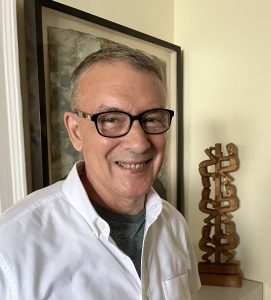
We are delighted to announce the Distinguished Scholar Session at the 111th CAA Annual Conference will honor Edward J. Sullivan. This session will highlight his career and provide an opportunity for dialogue between and among colleagues. This event will be held in-person at the New York Hilton Midtown during the 111th Annual Conference, February 16, 2022 at 4:30–6:00 pm.
Established in 2001, the Distinguished Scholar Session illuminates and celebrates the contributions of senior art historians. The Annual Conference Committee identifies a distinguished scholar each year who then invites a group of colleagues to create the session. The honoree’s involvement is fundamental to the series, which has become a tradition that gives voice to the continuities and ruptures that have shaped art-historical scholarship from the twentieth century into the new millennium.
Access to this program requires registration and is included with an All Access–level registration. Recordings will be accessible to registrants after the event. Register here.
Sullivan’s work has been transformative for the field of art history, especially in relation to the study and elevation of Latin American and Caribbean, Latina/o/x art and artists, and for the advancement of women and the BIPOC and LGBTQIA+ communities in these regions.
Edward J. Sullivan is the Helen Gould Shepard Professor in the History of Art at New York University (Institute of Fine Arts and the Department of Art History). Since receiving his PhD from NYU’s Institute of Fine Arts in 1979 (with a dissertation on painting in Madrid after the death of Velázquez) he has taught at Hunter College, Williams College, the University of Miami, and Trinity College, Dublin. However, his service as professor and administrator at New York University has been the defining aspect of his professional career. Sullivan has mentored hundreds of students at the undergraduate and graduate levels. His fields of research and teaching focus on a wide variety of geographical and temporal areas from Viceregal art in the Americas and the Philippines, to nineteenth-, twentieth-, and twenty-first-century art in Mexico, Central and South America, the United States, and the Caribbean. Sullivan has also had a parallel career as an independent curator and has worked on exhibitions in museums and cultural institutions throughout the US, Latin America, and Europe. He is the author of more than thirty books and exhibition catalogs, among which are The Language of Objects in the Art of the Americas (Yale University Press, 2007), Fragile Demon: Juan Soriano in Mexico 1935–1950 (Philadelphia Museum of Art, 2008), Continental Shifts: The Art of Edouard Duval Carrié (Haitian Cultural Institute 2008), Nueva York 1613–1945 (Scala Books, 2010), From San Juan to Paris and Back: Francisco Oller and Caribbean Art in the Era of impressionism (Yale University Press, 2014), Making the Americas Modern: Hemispheric Art 1910–1960 (Laurence King, 2018), and Brazilian Modern: The Living Art of Roberto Burle Marx (New York Botanical Garden, 2018).
The panel will include Ilona Katzew (Los Angeles County Museum of Art), Estrellita Brodsky (Another Space), Sean Nesselrode-Moncada (Rhode Island School of Design), Joseph Shaikewitz (Institute of Fine Arts), and Lynda Klich (City University of New York, Hunter College) as moderator.



